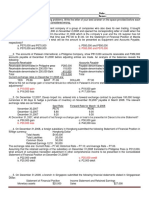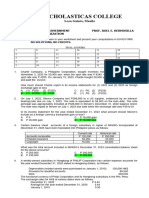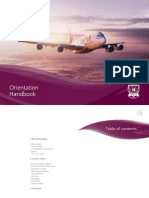Forex Transactions
Forex Transactions
Uploaded by
Ding CostaCopyright:
Available Formats
Forex Transactions
Forex Transactions
Uploaded by
Ding CostaOriginal Description:
Copyright
Available Formats
Share this document
Did you find this document useful?
Is this content inappropriate?
Copyright:
Available Formats
Forex Transactions
Forex Transactions
Uploaded by
Ding CostaCopyright:
Available Formats
FOREX TRANSACTIONS
1. On September 1, year 1, Baler Corp. received an order for equipment from a foreign customer
for 300,000 local currency units (LCU) when the Philippine peso equivalent was P96,000. Baler
shipped the equipment on October 15, year 1, and billed the customer for 300,000 LCU when the
Philippine peso equivalent was P100,000. Baler received the customer’s remittance in full on
November 16, year 1, and sold the 300,000 LCU for P105,000. In its income statement for the
year ended December 31, year 1, Baler should report as part of net income a foreign exchange
transaction gain of
a. P0
b. P4,000
c. P5,000
d. P9,000
2. On September 1, year 1, Vigan, a Philippine corporation, sold merchandise to a foreign firm
for 250,000 Japanese yen. Terms of the sale require payment in yen on February 1, year 2. On
September 1, year 1, the spot exchange rate was P.20 per yen. At December 31, year 1, Vigan
end, the spot rate was P.19, but the rate increased to P.22 by February 1, year 2, when payment
was received. How much should Vigan report as foreign exchange transaction gain or loss as part
of year 2 income?
a. P0.
b. P2,500 loss.
c. P5,000 gain.
d. P7,500 gain.
3. Mandaue, a Philippine corporation, bought inventory items from a supplier in Turkey on
November 5, year 1, for 100,000 Turkish lira, when the spot rate was P.4295. At Mandaue’s
December
31, year 1 year-end, the spot rate was P.4245. On January 15, year 2, Mandaue bought 100,000
pesos at the spot rate of P.4345 and paid the invoice. How much should Mandaue report as part
of net income for year 1 and year 2 as foreign exchange transaction gain or loss?
Year 1 Year 2
a. P 500 P(1,000)
b. P0 P (500)
c. P (500) P0
d. P(1,000) P 500
4. Guimaras Co. purchased merchandise for TWD300,000 from a vendor in Taiwan on
November 30, year 1. Payment in Taiwan dollar was due on January 30, year 2. The exchange
rates to purchase one TWD were as follows:
November 30, December 31,
Year 1 Year 1
Spot rate P1.65 P1.62
30-day rate 1.64 1.59
60-day rate 1.63 1.56
In its December 31, year 1, income statement, what amount should Guimaras report as foreign
exchange transaction gain as part of net income?
a. P12,000 c. P 6,000
b. P 9,000 d. P0
5. Lucena Corp. had the following foreign currency transactions during year 1:
Merchandise was purchased from a foreign supplier on January 20, year 1, for the
Philippine peso equivalent of P90,000. The invoice was paid on March 20, year 1, at the
Philippine peso equivalent of P96,000.
On July 1, year 1, Lucena borrowed the Philippine peso equivalent of P500,000
evidenced by a note that was payable in the lender’s local currency on July 1, year 3. On
December 31, year 1, the Philippine peso equivalents of the principal amount and accrued
interest were P520,000 and P26,000, respectively. Interest on the note is 10% per annum.
In Lucena’s year 1 income statement, what amount should be included as foreign exchange
transaction loss as part of net income?
a. P0 c. P21,000
b. P 6,000 d. P27,000
6. On November 30, year 1, Tyrola Publishing Company, located in Baguio, executed a contract
with Ernest Blyton, an author from Canada, providing for payment of 10% royalties on Canadian
sales of Blyton’s book. Payment is to be made in Canadian dollars each January 10 for the
previous year’s sales. Canadian sales of the book for the year ended December 31, year 2, totaled
P50,000 Canadian. Tyrola paid Blyton his year 2 royalties on January 10, year 3. Tyrola’s year 2
financial statements were issued on February 1, year 3. Spot rates for Canadian dollars were as
follows:
November 30, year 1 P.87 December 31, year 2 P.89
January 1, year 2 P.88 January 10, year 3 P.90
How much should Tyrola accrue for royalties payable at December 31, year 2?
a. P4,350
b. P4,425
c. P4,450
d. P4,500
7. Capiz Co. records its transactions in Philippine pesos. A sale of goods resulted in a receivable
denominated in Japanese yen, and a purchase of goods resulted in a payable denominated in
euros. Capiz recorded a foreign exchange transaction gain on collection of the receivable and an
exchange transaction loss on settlement of the payable. The exchange rates are expressed as so
many units of foreign currency to one peso. Did the number of foreign currency units
exchangeable for a peso increase or decrease between the contract and settlement dates?
Yen Euros
Exchangeable Exchangeable
for P1 for P1
a. Increase Increase
b. Decrease Decrease
c. Decrease Increase
d. Increase Decrease
8. On October 1, year 1, Mild Co., a Philippine company, purchased machinery from Grund, a
German company, with payment due on April 1, year 2. If Mild’s year 1 operating income
included no foreign exchange transaction gain or loss, then the transaction could have
a. Resulted in an extraordinary gain.
b. Been denominated in Philippine pesos.
c. Caused a foreign currency gain to be reported as a contra account against machinery.
d. Caused a foreign currency translation gain to be reported as other comprehensive income.
9. On October 1, year 1, Velec Co., a Philippine company, contracted to purchase foreign goods
requiring payment in Qatari riyals, one month after their receipt at Velec’s factory. Title to the
goods passed on December 15, year 1. The goods were still in transit on December 31, year 1.
Exchange rates were one dollar to twentytwo riyals, twenty riyals, and twenty-one riyals on
October 1, December 15, and December 31, year 1, respectively. Velec should account for the
exchange rate fluctuation in year 1 as
a. A loss included in net income before extraordinary items.
b. A gain included in net income before extraordinary items.
c. An extraordinary gain.
d. An extraordinary loss.
You might also like
- AccgovDocument11 pagesAccgovJanella Patrizia100% (2)
- The Challenge of Global Capitalism: The World Economy in the 21st CenturyFrom EverandThe Challenge of Global Capitalism: The World Economy in the 21st CenturyRating: 3 out of 5 stars3/5 (9)
- Qatari Eid Charity's Suspicious Donations To Obscure Nigerian GroupsDocument29 pagesQatari Eid Charity's Suspicious Donations To Obscure Nigerian GroupsDavid HundeyinNo ratings yet
- Quiz - Effects of ForexDocument8 pagesQuiz - Effects of ForexVicky CastroNo ratings yet
- Prerev FOREX 2019Document8 pagesPrerev FOREX 2019RojParcon50% (4)
- Foreign CurrencyDocument4 pagesForeign CurrencyDyheeNo ratings yet
- FinACt 5 Foreign Currency TransactionsDocument2 pagesFinACt 5 Foreign Currency TransactionsBedynz Mark Pimentel100% (2)
- 01 - Preweek Lecture and ProblemsDocument15 pages01 - Preweek Lecture and ProblemsMelody GumbaNo ratings yet
- FOREXQUIZ2021Document6 pagesFOREXQUIZ2021rodell pabloNo ratings yet
- Pattaya Property and Thailand's Real Estate - How to Buy Thai Condominiums, Apartments, Homes & VillasFrom EverandPattaya Property and Thailand's Real Estate - How to Buy Thai Condominiums, Apartments, Homes & VillasNo ratings yet
- Swot Analysis of Saudi Arabia Market Overview: ContinuityDocument10 pagesSwot Analysis of Saudi Arabia Market Overview: ContinuityManish KumarNo ratings yet
- Accounts Receivable Accounts Payable: A. P19,500 GainDocument6 pagesAccounts Receivable Accounts Payable: A. P19,500 GainTk KimNo ratings yet
- MATERIALDocument23 pagesMATERIALPocari OnceNo ratings yet
- FOREX - LectureDocument4 pagesFOREX - LectureJEP WalwalNo ratings yet
- Forex&Derivative HODocument7 pagesForex&Derivative HOMarielle SidayonNo ratings yet
- ACC 5116 - MODULE 3 - Lecture NotesDocument3 pagesACC 5116 - MODULE 3 - Lecture NotesCarl Dhaniel Garcia SalenNo ratings yet
- University of Luzon College of AccountancyDocument3 pagesUniversity of Luzon College of AccountancyJonalyn May De VeraNo ratings yet
- Accounting For Foreign Currency TransactionDocument4 pagesAccounting For Foreign Currency TransactionDymphna Ann Calumpiano100% (3)
- Forex Testbank This Give Practical Examples For Students To Master The Different Concepts in - CompressDocument12 pagesForex Testbank This Give Practical Examples For Students To Master The Different Concepts in - CompressMIKAELLA LALOGONo ratings yet
- NFJPIA Mockboard 2011 P1Document7 pagesNFJPIA Mockboard 2011 P1Jaymee Andomang Os-agNo ratings yet
- Advanced Financial Accounting & Reporting February 9, 2020Document8 pagesAdvanced Financial Accounting & Reporting February 9, 2020Ric John Naquila CabilanNo ratings yet
- Chapter 14 Multiple Choices: PROB. 14 - 1 (IAS)Document12 pagesChapter 14 Multiple Choices: PROB. 14 - 1 (IAS)jek vinNo ratings yet
- Chapter 10Document16 pagesChapter 10Kurt dela Torre0% (2)
- NFJPIA Mockboard 2011 P1 PDFDocument9 pagesNFJPIA Mockboard 2011 P1 PDFLei LucasNo ratings yet
- Finals-Business CombiDocument5 pagesFinals-Business Combijhell de la cruzNo ratings yet
- QuizDocument6 pagesQuizKathrine YapNo ratings yet
- Quiz 3 - Problems & SollutionsDocument12 pagesQuiz 3 - Problems & SollutionsRiezel PepitoNo ratings yet
- AfarDocument11 pagesAfarDonna Mae HernandezNo ratings yet
- Quiz 3 ProblemsDocument11 pagesQuiz 3 ProblemsRiezel PepitoNo ratings yet
- AFAR3 QuestionnairesDocument5 pagesAFAR3 QuestionnairesTyrelle Dela CruzNo ratings yet
- Week 10 - Foreign Exchange Transactions, Translation, and HyperinflationDocument6 pagesWeek 10 - Foreign Exchange Transactions, Translation, and Hyperinflationalvin quizonNo ratings yet
- Foreign Currency Transactions-HedgingDocument2 pagesForeign Currency Transactions-HedgingMixx MineNo ratings yet
- AFAR 3 AnswersDocument5 pagesAFAR 3 AnswersTyrelle Dela CruzNo ratings yet
- For ReviewDocument3 pagesFor ReviewJoeNo ratings yet
- Foreign CurrencyDocument7 pagesForeign CurrencyLoraine Garcia GacuanNo ratings yet
- Forex PDFDocument5 pagesForex PDFErika LanezNo ratings yet
- This Study Resource Was: C. P6,050,000 D. P53,900Document2 pagesThis Study Resource Was: C. P6,050,000 D. P53,900Nah HamzaNo ratings yet
- MQ1Document8 pagesMQ1alellieNo ratings yet
- Accounting For Foreign Currency TransactionDocument3 pagesAccounting For Foreign Currency TransactionWilmar Abriol0% (1)
- Drill Problems-Wps OfficeDocument6 pagesDrill Problems-Wps OfficeJp Ayalde0% (1)
- Resa Oct 2012 Pract 1 First Preboard W Answers PDFDocument10 pagesResa Oct 2012 Pract 1 First Preboard W Answers PDFGuinevereNo ratings yet
- Mq2 ProblemsDocument2 pagesMq2 ProblemsDJ NicartNo ratings yet
- Far 1Document3 pagesFar 1Raymundo EirahNo ratings yet
- FOREXDocument7 pagesFOREXpoppy2890No ratings yet
- ASSIGNMENT 407 - Audit of InvestmentsDocument3 pagesASSIGNMENT 407 - Audit of InvestmentsWam OwnNo ratings yet
- Mockboard - Practical Accounting 1Document8 pagesMockboard - Practical Accounting 1Jaymee Andomang Os-agNo ratings yet
- Test Bank P2 2010Document141 pagesTest Bank P2 2010Vaneza DayananNo ratings yet
- odit of equityDocument10 pagesodit of equitycullonmannylynNo ratings yet
- Foreign CurrencyDocument6 pagesForeign CurrencykatieNo ratings yet
- Forex ProbsDocument1 pageForex ProbsJULLIE CARMELLE H. CHATTONo ratings yet
- Quiz 4Document4 pagesQuiz 4Light_15_yagamiNo ratings yet
- 07 - Foreign Currency TransactionsDocument5 pages07 - Foreign Currency TransactionsMelody Gumba50% (2)
- Aec 22 - Take Home Long Quiz: Trading SecuritiesDocument4 pagesAec 22 - Take Home Long Quiz: Trading SecuritiesOriel Ricky GallardoNo ratings yet
- Mockboard AP PDFDocument6 pagesMockboard AP PDFKathleen JaneNo ratings yet
- NFJPIA - Mockboard 2011 - AP PDFDocument6 pagesNFJPIA - Mockboard 2011 - AP PDFJohnny EspinosaNo ratings yet
- Dollar Swap Fintech make 800% (Assets Market Rotation investing Formula) Pentagon Investing Method.Subtitle:Tears of JapanFrom EverandDollar Swap Fintech make 800% (Assets Market Rotation investing Formula) Pentagon Investing Method.Subtitle:Tears of JapanNo ratings yet
- Random 125.7Document6 pagesRandom 125.7Ding CostaNo ratings yet
- Random 125.8Document6 pagesRandom 125.8Ding CostaNo ratings yet
- UntitledDocument6 pagesUntitledDing CostaNo ratings yet
- Random 122Document6 pagesRandom 122Ding CostaNo ratings yet
- Random 125.4Document6 pagesRandom 125.4Ding CostaNo ratings yet
- Random 121Document6 pagesRandom 121Ding CostaNo ratings yet
- Random 125.2Document6 pagesRandom 125.2Ding CostaNo ratings yet
- Random 123Document6 pagesRandom 123Ding CostaNo ratings yet
- Random 111Document6 pagesRandom 111Ding CostaNo ratings yet
- Random 124Document6 pagesRandom 124Ding CostaNo ratings yet
- Random 116Document6 pagesRandom 116Ding CostaNo ratings yet
- Random 107Document6 pagesRandom 107Ding CostaNo ratings yet
- Random 113Document6 pagesRandom 113Ding CostaNo ratings yet
- Random 102Document6 pagesRandom 102Ding CostaNo ratings yet
- Random 115Document6 pagesRandom 115Ding CostaNo ratings yet
- Random 108Document6 pagesRandom 108Ding CostaNo ratings yet
- Random 104Document6 pagesRandom 104Ding CostaNo ratings yet
- Bonds 100Document2 pagesBonds 100Ding CostaNo ratings yet
- Random 101Document6 pagesRandom 101Ding CostaNo ratings yet
- Payroll r-2Document11 pagesPayroll r-2Ding CostaNo ratings yet
- Random 103Document6 pagesRandom 103Ding CostaNo ratings yet
- Random 106Document6 pagesRandom 106Ding CostaNo ratings yet
- Projected Rates Nov 2024 1Document6 pagesProjected Rates Nov 2024 1rathorerameshNo ratings yet
- Notification No.105/2020 - Customs (N.T.)Document2 pagesNotification No.105/2020 - Customs (N.T.)Sarvesh BansalNo ratings yet
- Monthly - Bulletin - of - Statistics - January - 2022 PDFDocument304 pagesMonthly - Bulletin - of - Statistics - January - 2022 PDFNaveed ShaheenNo ratings yet
- Projected Rates September 2024Document6 pagesProjected Rates September 2024khwajazeeshan737No ratings yet
- Orientation HandbookDocument19 pagesOrientation Handbookmastro100100% (2)
- Gulf Country Work PermitDocument2 pagesGulf Country Work PermitZeshan MustafaNo ratings yet
- Classification: ConfidentialDocument47 pagesClassification: ConfidentialJobin Thomas Stark EnergyNo ratings yet
- CBQ Toc Sept2017 enDocument13 pagesCBQ Toc Sept2017 enMITHUNNo ratings yet
- Excess Baggage Rates - Qatar AirwaysDocument2 pagesExcess Baggage Rates - Qatar AirwaysEdward OropezaNo ratings yet
- Research Proposal: Tanya Ahmed (Tya) Lecturer Department of ManagementDocument20 pagesResearch Proposal: Tanya Ahmed (Tya) Lecturer Department of ManagementEjajNo ratings yet
- PO NO. 161027 - J1904 - Sigma Metal - 14.12.22Document3 pagesPO NO. 161027 - J1904 - Sigma Metal - 14.12.22abdul jackilNo ratings yet
- Numbers As Words 1Document12 pagesNumbers As Words 1Denis LeonardNo ratings yet
- Riyal To Dollar - Google SearchDocument1 pageRiyal To Dollar - Google SearchWissam WissNo ratings yet
- Screen Shot 24-MarchDocument1 pageScreen Shot 24-Marchksaeed7860No ratings yet
- Sheikh Faleh Bin Nasser Al Thani Quran CompetitonDocument4 pagesSheikh Faleh Bin Nasser Al Thani Quran CompetitonsyedNo ratings yet
- Upda Qatar InfoDocument2 pagesUpda Qatar Inforommel duran100% (5)
- Trade BackTestDocument8 pagesTrade BackTestDriez 1No ratings yet
- QatarDocument24 pagesQatarosasNo ratings yet
- Compulsary Mathematics - Class 10Document348 pagesCompulsary Mathematics - Class 10Rüpësh ẞhäñdårîNo ratings yet
- Pakistan Balance PaymentDocument56 pagesPakistan Balance PaymentAtiqueNo ratings yet
- Amadeus Reissueance PackageDocument92 pagesAmadeus Reissueance PackageAHMED ALRADAEENo ratings yet
- How To Settle in QatarDocument23 pagesHow To Settle in QatarAbs ShahidNo ratings yet
- ZEDPolicyDocument11 pagesZEDPolicyvsud163No ratings yet
- Quotation: User ID: 14HEMPDocument1 pageQuotation: User ID: 14HEMPjondutta189No ratings yet
- AGENCY AGREEMENT - 17ap.2021Document1 pageAGENCY AGREEMENT - 17ap.2021Armando VNo ratings yet
- Numbers As Words 1Document13 pagesNumbers As Words 1Kaushal KumarNo ratings yet
- Exchange Rates Against UAE Dirham For VAT Related Obligations. December 2019Document36 pagesExchange Rates Against UAE Dirham For VAT Related Obligations. December 2019azizNo ratings yet
- Daily Market Report On 10 May 2021Document10 pagesDaily Market Report On 10 May 2021Chiranjaya HulangamuwaNo ratings yet













































































































